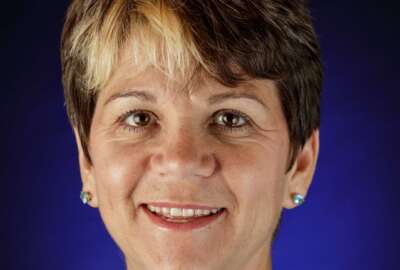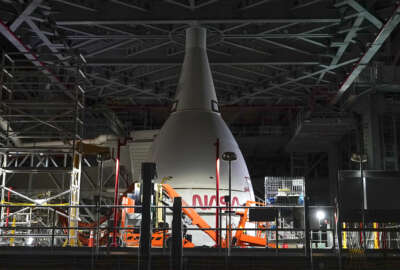Hubbard Radio Washington DC, LLC. All rights reserved. This website is not intended for users located within the European Economic Area.
On Air: Federal News Network
Trending:
Why NASA has a crucial need to transform itself from the agency of the 80s
NASA, famously and consistently the best place to work in government, has an urgent need to transform itself and how it operates. That's the principal finding o...
Best listening experience is on Chrome, Firefox or Safari. Subscribe to Federal Drive’s daily audio interviews on Apple Podcasts or PodcastOne.
NASA, famously and consistently the best place to work in government, has an urgent need to transform itself and how it operates. That’s the principal finding of the Aerospace Safety Advisory Panel, in its latest annual report to Congress. For highlights, the Federal Drive with Tom Temin turns to the panel chair, Dr. Patricia Sanders.
Interview transcript:
Tom Temin: Dr. Sanders, good to have you on.
Patricia Sanders: Good morning.
Tom Temin: The thing that struck me in reading your report was that you pointed out clearly the degree to which NASA is becoming more and more dependent on commercial industry for a lot of what it does, but then you write that the agency is at an inflection point in its need for transformation. Tell us what you meant by that.
Patricia Sanders: They have been over the last at least decade, becoming more and more engaging in taking advantage of the innovations in commercial space. Whereas years ago, NASA was it. They did pretty much everything for space, some military applications, obviously, but they were the developer, the operator, now there’s a number of things they cannot purchase, services, because they’re being developed by the commercial industry for other customers. And this has a two edged sword. On one hand, they can take advantage of these capabilities, it leaves NASA freer to push the edges of the envelope, then expand that and at the same time use capabilities that are being developed for more customers at once. The flip side of that when where the safety panels gets engaged is it has the potential that you can blur the outlines on safety accountability and risk management, because you’re now buying something that you don’t have full control of. And NASA has been working their way through this, they did it with the commercial resupply program with the commercial crew program, and have learned a lot of lessons on how to manage this sort of thing. But that’s been in one pocket of the organization. And it’s been sort of a, as we’ve characterized it, a tactical approach to work your way through, not a bad way to start. But we’ve felt that right now with the major Artemis initiative, the moon and Mars, where you have so many more components that are either internationally provided or commercially provided where NASA sets the requirements, but doesn’t control the design, doesn’t own the hardware. They do own the requirements, and they do own the responsibility for safety of their astronauts, they needed to step back and take a strategic look at this and say, OK, what are going to be our criteria for the things that we make ourselves that we buy as services that we manage somewhere in between? And, how are we going to manage that shared responsibility for the risk?
Tom Temin: And so the transformation then relates to that question primarily, are there larger issues?
Patricia Sanders: That’s the foundational question. It isn’t that there’s one size that fits all, you know, and every component of this Artemis initiative, but that you need to really decide what your guiding principles are going to be. And also, make sure your whole workforce and your stakeholders understand what those guiding principles are. Sometimes your people inside or outside of the organization will say, oh, NASA is going to go buy everything commercial now. That’s not really true. But you can get a false impression if you don’t actually establish those guiding principles, and then makes them clear to everyone. So we just felt with the complexity of what they’re doing. I mean, they’re entering into some very complex environments. Now, they’re going farther away than low Earth orbit. Yes, they’ve been to the moon before, but it was not like they’re going this time. And every mission is going to be unique and have different components. So it’s really time to step back and make sure you understand where you’re going.
Tom Temin: All right, we’re speaking with Dr. Patricia Sanders. She’s chairman of the Aerospace Safety Advisory Panel. And by the way, former executive director of the Missile Defense Agency. And the report talks about the differences among the various large NASA centers that each traditionally had a specific mission. And now that’s getting somewhat blurred. But you also write that the competition and the rivalry among the centers still exists to some degree, maybe discuss what they need to do to flatten that all out?
Patricia Sanders: Well, we did make a recommendation along those lines. I’m not trying to tell NASA exactly how to organize but saying that they really needed to treat their center directors more like they would a board of directors of sorts. Not that you have to call it a board of directors, but they need to act and behave and be held accountable for NASA’s agency strategic objectives first, and then how does my center and its capabilities support that as opposed to sort of, you know, this is my center. This is sort of my fiefdom. I want to protect my workers here and my work and be in competition with each other. I think that’s in the realm of possible but there’s some history to overcome.
Tom Temin: Sure, I guess maybe a different generation of leadership up and coming might be able to overcome that perhaps more than people that date back to the, say, the space shuttle era. And you also mentioned the lingering effects of constant shifts in national strategy, from administration to administration. It’s almost like an irresponsible way of treating NASA between administrations and Congress. So there’s no continuity of what they’re supposed to be doing. Is that largely do you think over with? Or are there still effects from it?
Patricia Sanders: Well, it’s hard to tell. But in the most recent shift of administrations, they have managed to keep the continuity, which is given that you’ve gone from one very different administration to the next in many dimensions. This is one where they seem to maintain continuity. And that’s going to be important. When you’re saying, OK, first you’re going to the moon and then to Mars, then you say, no, we’re not going to go to the moon, we’re just going to go to Mars, no, we’re not going to do either of those right now we’re going to do an asteroid visit. It gets hard to one, manage the resources, but also, it puts them in a sort of a place where they were developing piece parts, that would be components of a capability that could go almost any direction, if they could put them together, right. But you pay a price in the how you’re integrating those, and not having an overall program management because you really don’t have a fully integrated management system. And they have an opportunity now, and I know that they’ve got some reorganization restructuring going on. And we’re hoping that they will take our recommendation to heart and we’ve been sort of reassured that yes, they believe they need to go in that direction of having an integrated program management structure. What that structure will look like, and whether it’ll meet the objectives that we’re encouraging them towards is still yet to be seen.
Tom Temin: Yeah, that universal interchangeable parts platform idea has rarely worked in almost any industry. It took the car companies 60 years to figure it out, and they haven’t fully figured it out either. So I understand what you’re saying, there.
Patricia Sanders: It’s a lot harder than just having interface standards. That’s a necessary but not sufficient component to this, and it’s very challenging integration issues,
Tom Temin: End up with a littoral combat ship of the skies, I guess, they could go that way. And you also, of course, you report to Congress, the ASAP panel every year. And you have some recommendations there also.
Patricia Sanders: Yes, we have a few there. And we have a couple of formal ones. One really, really important one to us. It’s important to NASA, but it’s really important to the entire international global space community, is to deal with the overall space traffic management space, situational awareness issues. With the amount of debris that’s collecting up there, and the number of satellites that are being launched, it’s really important to sort of have some rules of the road and have some leadership in this age. And there are a lot of commercial capabilities in this country and other places around the world that could be brought to bear on these issues. But it needs a leader, it needs somebody to take charge and go and that’s been our recommendation to Congress is designate a responsible agency and give them the resources to take the leadership role here. Not that they have to do everything. It’s just that somebody needs to be in charge. And a good portion of the global world would follow leadership of somebody would take it.
Tom Temin: Interesting. Yeah. So in that sense, NASA is tied in intergovernmentally pretty deeply with, well, say your old agency, the Missile Defense Agency, the Space Command, the U.S. Space Force now that there has been established that for a couple of years, and also the different other components of the Defense Department, just to name a few.
Patricia Sanders: Yes. So that recommendation, because we are charged to be advisors, not just to NASA, but to the Congress, we feel free to give them recommendations, too.
Tom Temin:
And then there’s always the recommendation, pass your budget on time, folks.Patricia Sanders: Yeah, that’s like pushing a wet noodle. But it’s really hard to manage a program when you don’t really know what resources you’re going to have for the year. And it should be job one for Congress. But somehow we have not had a year without continuing resolutions since well, before 2008.
Tom Temin: Well, that might be the next race. Either NASA gets to Mars first or Congress passes a budget on time first.
Patricia Sanders: It’s also the least efficient way to spend money.
Tom Temin: Sure. All right, from the panel’s lips to Congress’s ears. Dr. Patricia Sanders is chair of the Aerospace Safety Advisory Panel. Thanks so much for joining me.
Patricia Sanders: You’re welcome.
Copyright © 2024 Federal News Network. All rights reserved. This website is not intended for users located within the European Economic Area.
Tom Temin
Tom Temin is host of the Federal Drive and has been providing insight on federal technology and management issues for more than 30 years.
Follow @tteminWFED
Related Stories
Related Stories
-
NASA’s future plans with and without the ISS The Space Hour
-
Former NASA CIO explains how adversity makes strong leaders Leaders and Legends





